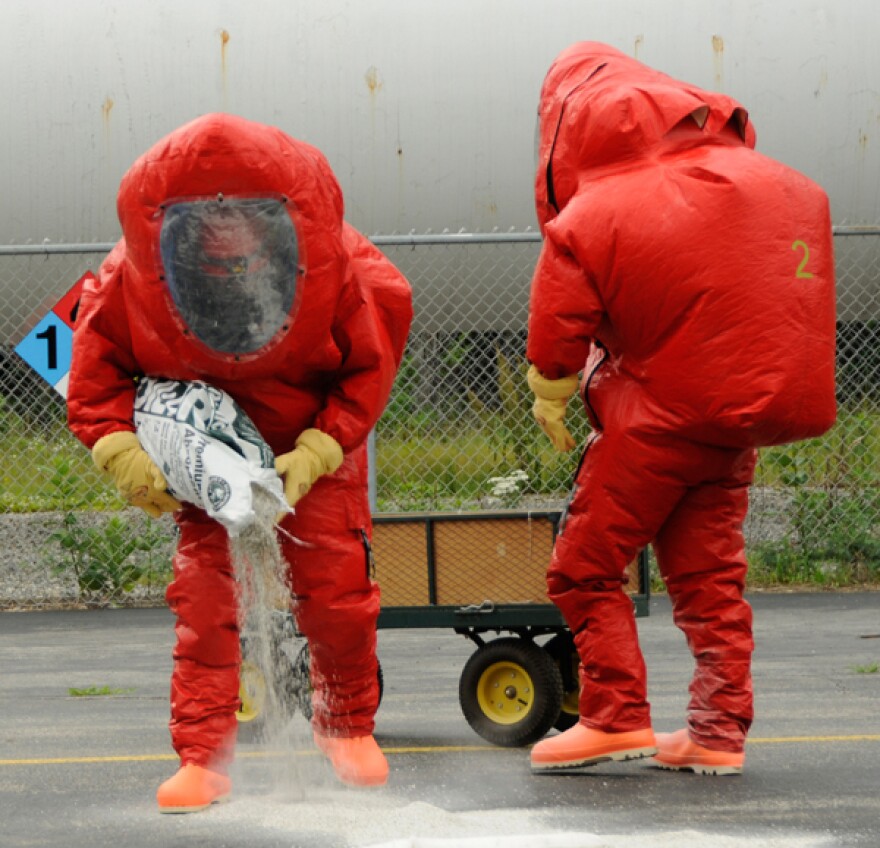In May, local Drug Enforcement Administration agents, along with Kansas City police, raided a house in Kansas City, Kansas.
What they found surprised them: 16 pounds of the synthetic opioid fentanyl.
"We had no idea that it was 100 percent fentanyl," says DEA special agent Troy Derby.
But they were certainly aware of the risks of even a minute amount of the powerful opioid.
The task force agents and police were equipped with Tyvek body suits, self-contained breathing apparatuses, inner and outer gloves, and boots.
“We seal up every joint,” Derby says. “So we’re not breathing any of that same air. We’re not touching anything, and nothing can touch our skin.”
If it sounds extreme, it's because fentanyl is unusually potent. Unlike heroin, which is derived from the poppy plant, fentanyl is chemically manufactured. And whereas a dose of heroin is measured in milligrams, one of fentanyl is measured in micrograms.
“Imagine taking one grain of salt and dividing it six ways,” Derby says. “One of those pieces could actually kill you.”

Fentanyl isn’t new — it's used medicinally, prescribed by doctors for patients with cancer or severe chronic pain, usually in the form of a patch. But in recent years it has entered the illegal opioid market.
Derby says traffickers have learned that the profit margin for fentanyl is huge. It’s easy to transport and it commands a very high price.
In contrast to the East Coast, which has been hit hard by fentanyl over recent years, the Midwest has remained relatively unscathed. Based on recent seizures, however, Derby says that’s changing.
He says the seizure in KCK was the first time law enforcement in the metropolitan area had encountered such a large amount of fentanyl.
“Most of the time all our seizures are (of fentanyl) passing through Kansas City, going to New York; Columbus, Ohio; and larger cities," Derby says. "But this was the first encounter with fentanyl at that quantity coming here.”
Traffickers and distributors are using fentanyl to lace heroin, then marketing it as a more intense drug. That's appealing to an addict chasing the highest high.
“What scares me for the addict is that fentanyl mixes into heroin and it resembles heroin," says recovering addict Jeff Howard, founder and CEO of Midwestern Recovery Center. "And there's no warning label on that packaging.”
As someone whose own addiction escalated from alcohol to cocaine to heroin, he understands why an addict might turn to fentanyl.
“The more you use, the less it works, the more you need,” Howard says.
But using fentanyl he says, is like playing Russian roulette. A small dose can result in death.
“What happens is you stop breathing,” says University of Kansas Hospital emergency room doctor Stephen Thornton.

Thornton, who's also director of the University of Kansas Hospital Poison Control Center, says that's what sets fentanyl apart from other controlled substances like cocaine or methamphetamines.
“Yes, they can cause very bad problems,” he says. “But typically, one dose isn't going to kill you. But you know you're going to accidentally kill yourself with these opioids, especially fentanyl.”
There is a way to block an overdose. Naloxone, also known as Narcan, is a medication that can reverse the toxic effects of an overdose.
A bill recently adopted by the Kansas State Board of Pharmacy allows pharmacists, on a temporary basis, to supply Narcan without a prescription to patients, bystanders, school nurses and first responders. That's important because multiple doses of Narcan are often needed to counter fentanyl's fast-acting, deadly effects.
It's hard to say how much of a new threat fentanyl represents. There’s no national system that reports fentanyl-induced deaths or overdoses. Reports to the police or poison control are voluntary. And so far, there are no drug tests to detect fentanyl.
“It makes it a bigger challenge because, without knowing the scope of the problem you don't really know how to respond to it,” Thornton says.
What the DEA can say is that 2016 fentanyl submissions to the DEA lab covering a six-state region in the Midwest are up 600 percent over those in 2014. And roughly midway through 2017, that number has already tripled.
Andrea Tudhope is a reporter and producer for KCUR 89.3. Email her at andreat@kcur.org, and follow her on Twitter @_tudhope.




